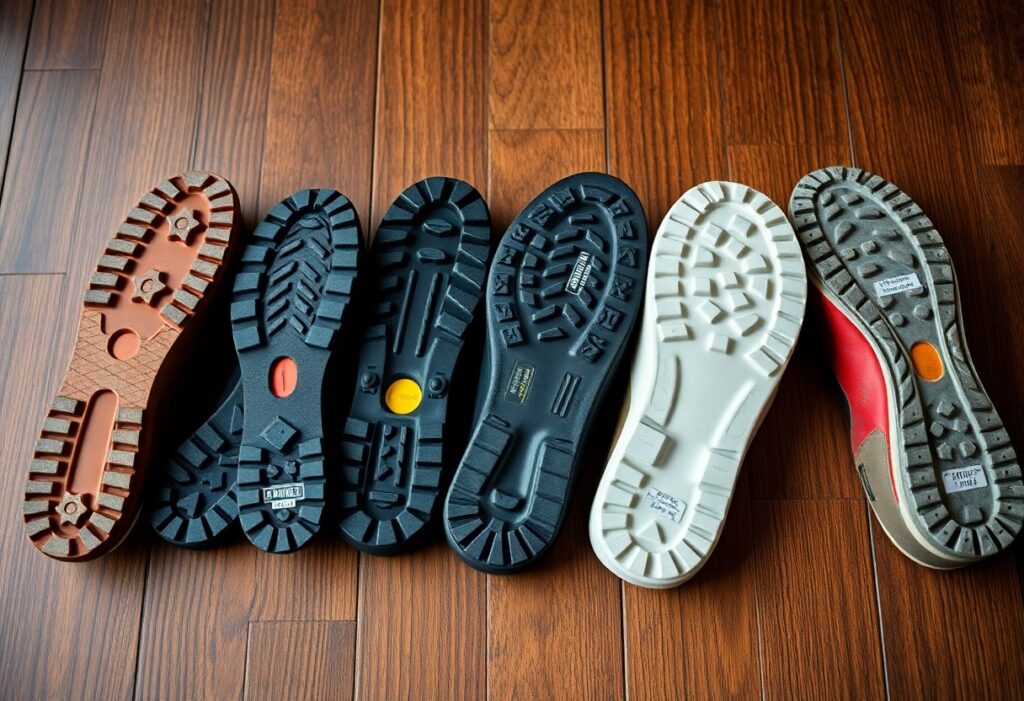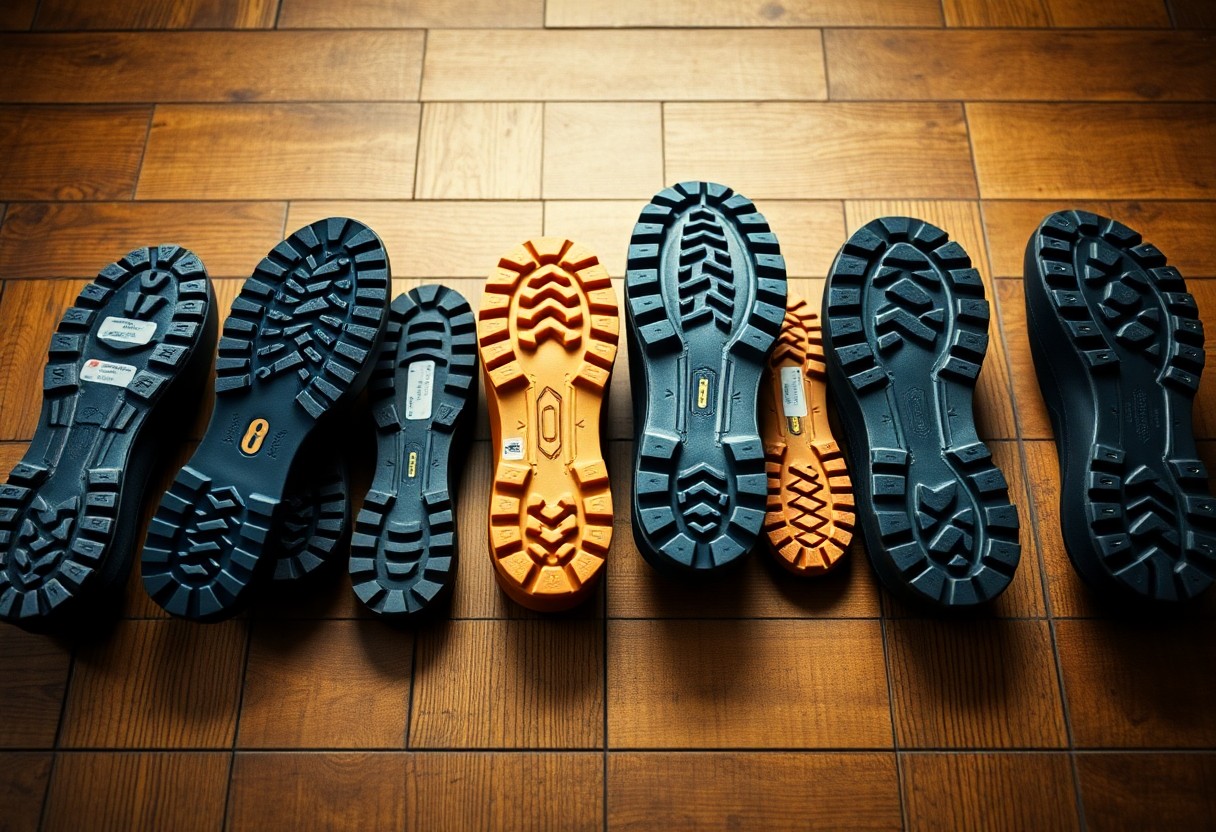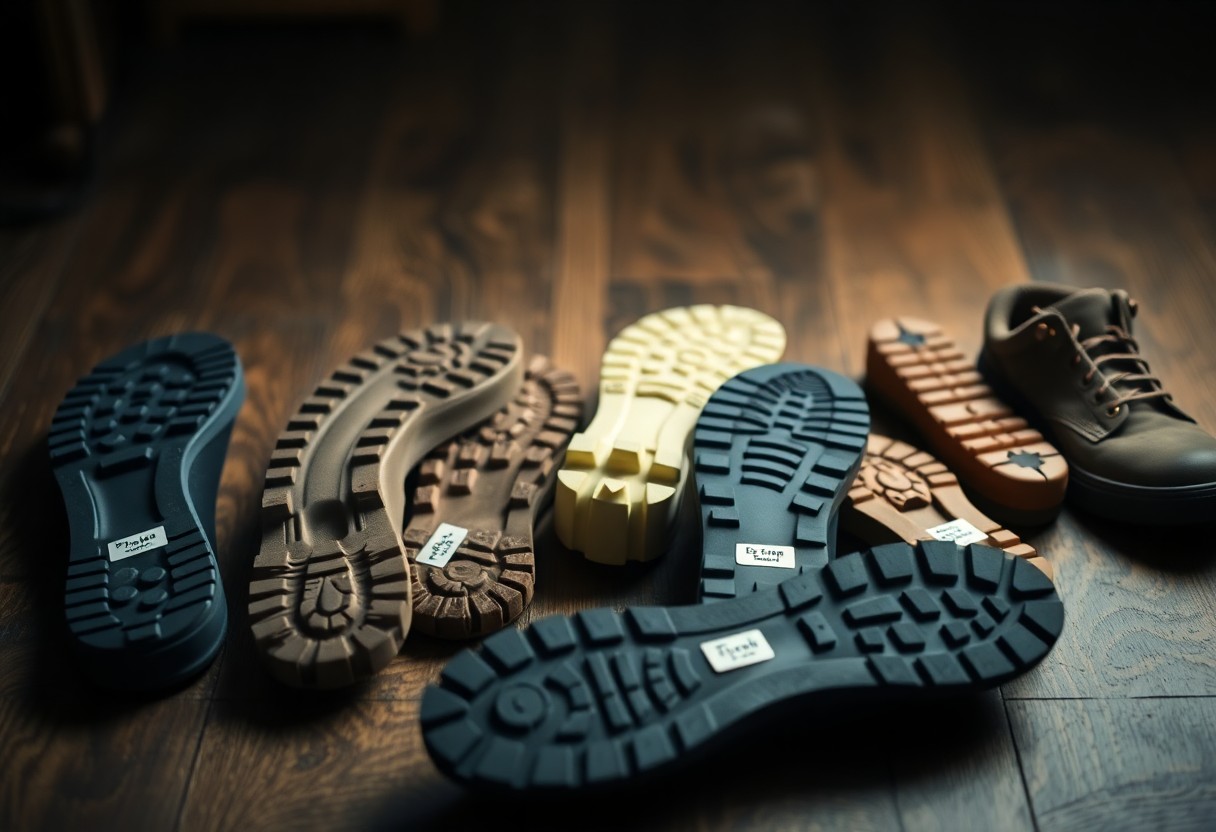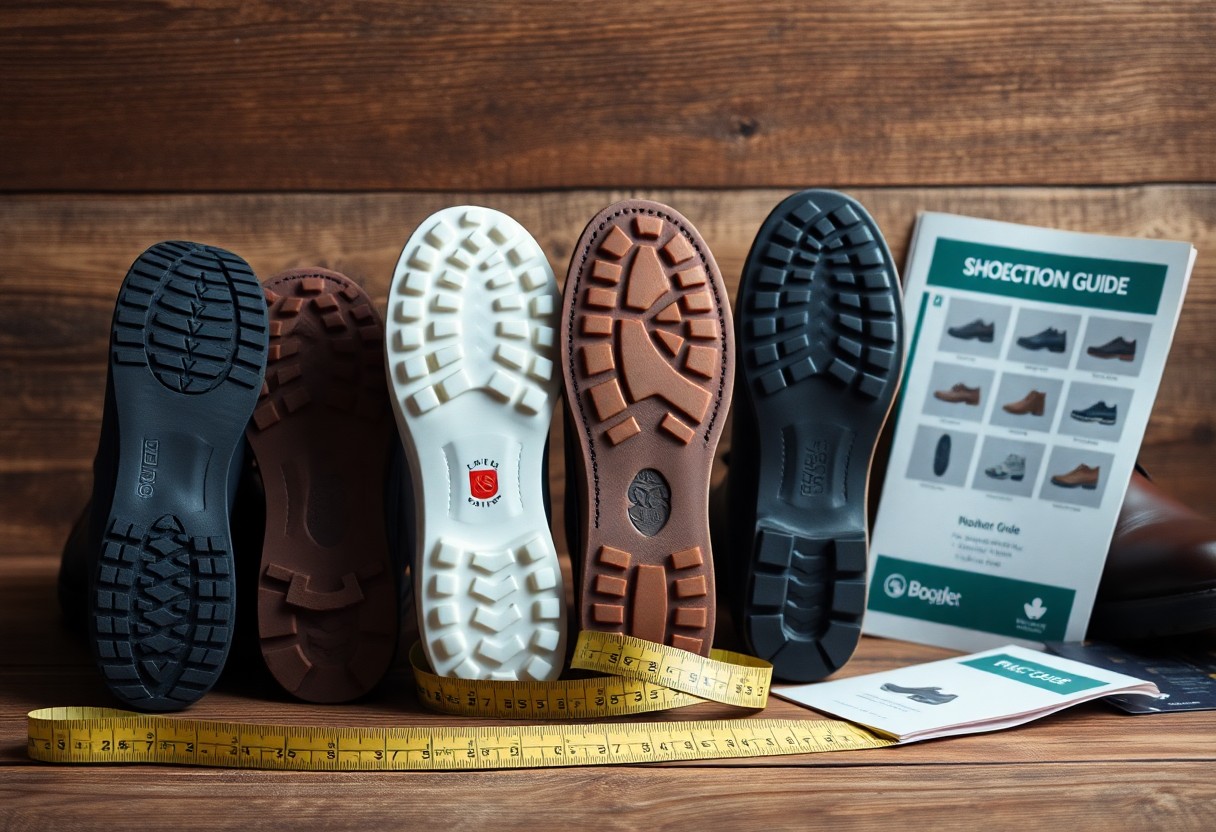
When choosing the right footwear, many people often overlook the essential aspect of shoe soles, which play a vital role in ensuring both comfort and safety. The type of sole you select can dramatically impact your ability to achieve stable footing on slippery surfaces and can mean the difference between enjoying long-lasting comfort or facing rapid wear and tear. Ranging from classic leather soles to advanced rubber compounds, each sole type offers distinct advantages tailored for specific activities. Your options include single leather, double leather, rubber, and hybrid soles, each meticulously designed for various conditions and uses. This comprehensive guide will clarify the defining features of different sole types and help you choose the ideal option that meets your unique requirements, whether for professional, casual, or outdoor settings.

Unlock the Performance Advantages of Leather Soles for Footwear
Your choice of leather soles can profoundly influence both the aesthetic appeal and functional performance of your footwear. These traditional soles are celebrated for providing exceptional breathability and natural comfort, as they adapt to the shape of your feet over time, ensuring a customized fit. While they do require more maintenance than synthetic options, leather soles offer outstanding ground feel, making them particularly well-suited for formal occasions where style is essential. By understanding the unique benefits associated with leather soles, you can make a well-informed choice that not only elevates your wardrobe but also enhances your overall walking experience.
Elevate Your Style with the Timeless Appeal of Single Leather Soles
Soles constructed from a single layer of leather represent the most traditional option for sophisticated dress shoes. Designed to provide remarkable flexibility and a refined look, these soles elevate your style for formal gatherings. While they offer superior breathability compared to rubber alternatives, it’s essential to exercise caution in wet conditions to prevent potential damage. By opting for single leather soles, you embrace a polished aesthetic while benefiting from the comfort that high-quality craftsmanship provides, ensuring you look and feel your best during important occasions.
Invest in Long-Lasting Performance with Double Leather Soles
With two layers of leather, double leather soles offer you enhanced durability and superior insulation against cold surfaces. Although they may feel slightly stiffer than single-layer soles, they deliver extra protection for your feet under various conditions. This design guarantees that double leather soles will outlast their single-layer counterparts significantly, making them an excellent investment for everyday wear. They are particularly well-suited for individuals with a heavier build or those engaged in frequent outdoor activities, although they do necessitate a longer break-in period to achieve optimal comfort.
By selecting double leather soles, you are investing in a solution that successfully merges durability with performance, ensuring your footwear can endure the demands of daily use while maintaining an elegant appearance.
Enhance Footwear Performance with HAF (Half and Full) Soles
HAF soles combine single leather in the waist and heel with double leather in the forepart, offering the best of both worlds. This innovative design provides you with additional durability where it matters most while ensuring a sleek and elegant profile. The unique construction of HAF soles promotes balanced weight distribution and increased comfort, effectively protecting high-wear areas without compromising the shoe’s refined appearance. However, it is crucial to have your cobbler incorporate appropriate heel compensation to achieve optimal balance and support for your feet.
Explore the Versatile Nature of Natural and Mixed Soles for Daily Activities
Natural and mixed soles offer a well-rounded blend of comfort and durability, integrating organic materials like cork, natural rubber, or leather with synthetic compounds to create versatile and high-performing footwear solutions. Choosing among the various natural and mixed soles should depend on your specific needs regarding grip, weight, and resistance to different weather conditions. By understanding these factors, you can make an informed decision that aligns with your lifestyle and daily activities, ensuring your footwear meets your expectations.
Discover Lightweight Comfort with Nitrile Cork Soles
In addition to traditional rubber options, nitrile cork soles present a lightweight alternative that does not compromise on durability. These soles, which blend cork with nitrile rubber, are 30% lighter than standard rubber soles, making them a popular choice for American footwear where comfort is paramount. Offered in both smooth and treaded patterns, nitrile cork soles are ideal for individuals who prioritize lightweight footwear without sacrificing performance. Choosing these soles enables you to engage in daily activities with ease, style, and confidence.
Achieve Casual Comfort with Natural Crepe Soles
Constructed from pure rubber, natural crepe soles deliver exceptional comfort through their soft, cushioning properties. These soles are best suited for casual footwear and provide varying levels of grip depending on the surface conditions you encounter. While crepe soles offer superior comfort for everyday wear, they do have some drawbacks. Their softer composition leads to a wear rate that is approximately 40% faster than traditional rubber soles, and their grip may become unreliable on wet surfaces. Thus, while many users appreciate the comfort they offer, it’s important to consider the potential need for more frequent replacements.

Unveil the Advantages of Rubber Soles for All-Weather Versatility
Rubber soles distinguish themselves in the footwear market by providing superior grip and water resistance that surpasses leather options. These soles are particularly advantageous in wet conditions, making them the perfect choice for everyday wear across diverse weather scenarios. Rubber soles offer excellent durability and require less maintenance than leather alternatives, although they may feel warmer on your feet during the hotter summer months. The practical benefits of rubber soles make them an intelligent choice for individuals seeking reliable performance and comfort in their footwear.
Achieve the Perfect Combination with Rubber Topy Soles
Rubber Topy soles effectively bridge the gap between leather and rubber soles, providing you with the best of both worlds. With this design, you gain the classic aesthetic of leather soles while enjoying enhanced grip and durability. A thin rubber layer is adhered to a slightly sanded leather sole, significantly extending the lifespan of your footwear by up to 50%. This combination allows you to relish the visual appeal of leather without compromising functionality, making Rubber Topy soles a smart addition to your footwear collection.
Experience Style and Practicality with City Rubber Soles
By selecting city rubber soles, you achieve a sleek, dress shoe appearance without sacrificing practicality. These thin rubber soles closely resemble traditional leather soles while providing improved traction and waterproofing. Increasingly popular in contemporary dress shoes, city rubber soles not only enhance the visual allure of your footwear but also improve longevity compared to leather soles, requiring less frequent resoling. Perfect for urban settings, these soles can effortlessly navigate concrete sidewalks and occasional rain, ensuring you remain stylish and comfortable.
Optimize Footwear Durability with Dainite and Studded Soles
Among rubber options, Dainite and studded soles deliver maximum durability and grip. Their distinctive studded design ensures reliable traction while maintaining a formal appearance, making them particularly suitable for business casual footwear and dress boots. While Dainite soles are highly resistant to wear, it’s essential to note that they may become slippery in freezing conditions. User experiences can vary, as some might find them firmer compared to other sole types. However, for everyday wear in moderate conditions, these soles generally last 2-3 times longer than traditional leather soles, making them an excellent durability choice.
Essential Performance Features of Shoe Soles to Consider
Your selection of shoe sole can significantly affect your daily comfort and safety. Different sole types offer varying levels of grip, shock absorption, and flexibility, each serving unique functions that can prevent slips on wet surfaces or alleviate foot fatigue during extended walking periods. By understanding these performance features, you can choose the right sole type that enhances your overall footwear experience.
Assess Durability Characteristics of Sole Materials
The lifespan of various sole materials can differ widely in terms of wear resistance. Typically, rubber compounds outlast leather soles by 3-4 times, while nitrile cork serves as a middle ground. Factors such as material density and tread pattern are critical in determining the longevity of your soles. Being aware of these durability factors empowers you to make cost-effective footwear choices tailored to your specific lifestyle and activities.
Understand Weather Resistance for Optimal Sole Function
Key factors such as water resistance, temperature tolerance, and traction are vital in assessing how your soles will perform across different conditions. Generally, rubber soles provide superior grip in wet environments, while leather soles excel in dry conditions. It’s important to remember that temperature fluctuations can greatly impact sole performance. Some rubber compounds may become dangerously rigid in freezing temperatures, while others retain their flexibility. Your local climate should guide your choice: city rubber soles are ideal for mild wet conditions, while specialized winter soles offer enhanced safety in snowy or icy climates.

Your Complete Guide to Choosing the Right Shoe Sole
Recognizing that not all shoe soles are created equal is crucial; your choice should align with your specific needs and preferences. The right sole type can significantly impact your comfort, safety, and the longevity of your footwear. This guide is designed to aid you in selecting the most suitable sole type based on your lifestyle, activities, and environmental conditions.
Factor in Your Daily Activities When Selecting a Sole
When deciding on a sole, it’s essential to consider key aspects like your daily activities and the walking surfaces you frequently encounter. For office environments, thin leather or city rubber soles are appropriate. On the other hand, industrial settings benefit from thick rubber or studded soles that offer enhanced protection. For outdoor activities, focus on grip requirements and durability needs. Understanding your primary use will help narrow down the best options available for your footwear.
Evaluate Climate Considerations for Optimal Sole Performance
In addition to weather conditions, temperature variations can affect shoe sole performance. Here are some key considerations:
- Wet conditions – rubber soles deliver superior grip
- Cold weather – thicker soles provide better insulation
- Hot climates – breathable leather soles are optimal
- Variable weather – hybrid soles offer versatility
Understanding your local climate patterns is vital for selecting the most suitable sole type for your footwear.
Additionally, consider how different sole materials react to various weather conditions:
- Leather soles require special care in wet environments
- Rubber soles can become very hard below 0°C
- Nitrile cork offers a good balance in moderate conditions
- City rubber soles provide year-round versatility
Being aware of these characteristics ensures your footwear will perform well in every season.
Critical Maintenance and Care Tips for Longevity
To maintain the longevity and performance of your shoe and boot soles, regular upkeep is essential. The lifespan of your soles is significantly influenced by proper care, which includes cleaning, drying, and applying protective treatments. Each sole material has specific care needs; for instance, leather soles require waterproofing, while rubber soles benefit from regular debris removal.
Establish Effective Cleaning Routines for Your Footwear
A well-maintained sole starts with a consistent cleaning regimen. To preserve the integrity of your footwear, you should:
- Use a soft brush to gently eliminate dirt
- Clean with mild soap and water
- Employ specialized cleaners suited for specific materials
- Ensure thorough drying following cleaning
Understanding the appropriate cleaning techniques for your specific sole type will help prevent damage and prolong the life of your footwear.
Implement Preservation Strategies for Extended Sole Life
To extend the life of your soles, consider the following strategies:
- Rotate your footwear daily to allow for proper ventilation
- Utilize shoe trees during storage to maintain shape
- Apply protective sprays as required for additional safeguarding
- Regularly monitor for wear patterns to detect signs of deterioration
By recognizing early signs of wear, you can take proactive measures to prevent irreversible damage to your footwear.
It’s important to note that preservation methods can vary significantly based on the sole type:
- Leather soles need waterproofing every 3-4 months
- Rubber soles should be routinely checked for cracks
- Cork soles require protection from moisture
- Crepe soles should be protected from extreme heat
Understanding the specific needs of your sole type ensures effective maintenance and longevity of your footwear.
Empower Your Footwear Choices with Informed Decisions
Ultimately, your selection of shoe sole is crucial in determining your comfort and overall performance. It’s essential to match your sole type with your distinct needs—whether that means choosing leather soles for formal events or rubber variants for unpredictable weather. Considerations such as lifestyle, walking surfaces, and local climate should influence your decision. For example, single leather soles provide elegance for dress shoes, while Dainite or city rubber soles enhance grip and durability. By deepening your understanding of the various sole types and their unique benefits, you can make informed footwear choices that cater to your daily requirements and personal preferences.
Answers to Common Questions about Shoe Soles
Q: What are the main differences between leather and rubber soles?
A: Leather soles are acknowledged for their superior breathability and ability to conform to your feet over time, making them ideal for dress shoes. They perform well in dry conditions but require careful handling in wet weather. On the other hand, rubber soles provide better water resistance and grip, generally last longer, and are suitable for various weather situations. Additionally, rubber soles tend to be more affordable and require less maintenance compared to leather options.
Q: How do I choose the right sole type to meet my daily needs?
A: To select the appropriate sole type, consider your primary environments and activities. For formal office settings, choose leather soles, while rubber soles are preferable for outdoor walking and wet conditions. For versatility across different weather scenarios, studded soles like Dainite are an excellent choice. For casual wear, crepe soles deliver great comfort but may wear out more quickly. Align your sole type with your most frequent activities and environmental conditions to ensure optimal performance.
Q: What are the benefits of double soles compared to single soles?
A: Single soles offer greater flexibility and a sleeker profile, making them ideal for dress shoes. Conversely, double soles are designed for added durability and better insulation against cold and damp conditions. They are suitable for casual shoes and boots but do require a longer break-in period. While double soles may add some weight to the shoe, they also provide additional protection for navigating challenging terrains.
The Article Guide to shoe and boot sole types features benefits and how to choose the right one appeared first on My Shoes Finder
The Article Shoe and Boot Sole Types: Features, Benefits, and Selection Tips Was Found On https://limitsofstrategy.com


I really appreciate how you’ve highlighted the importance of shoe soles in this post. It’s surprising how often people focus primarily on style or brand when it comes to footwear, without considering how crucial the sole can be for overall comfort and safety. I’ve personally found that investing in good quality soles has not only improved my comfort during long days on my feet but also helped me navigate various terrains more confidently, especially during winter when slipping becomes a concern.
It’s great to hear your perspective on the importance of shoe soles, especially regarding comfort and safety. It’s interesting how easy it is to get caught up in the allure of aesthetics or brand names when choosing footwear, but a quality sole truly makes all the difference in day-to-day experiences.
I completely agree with your thoughts on shoe soles. It’s so easy to get lured in by trendy designs or popular brands, but I’ve learned the hard way that a comfortable and supportive sole can make a world of difference. I used to prioritize looks over functionality, especially when I was younger, but after experiencing some foot pain during long days on my feet, I shifted my perspective.
I really enjoyed your thoughts on shoe soles; if you’re interested in keeping that comfort and safety in top shape, I recently came across an article about choosing the right shoe brush that might be helpful.
‘Shoe Brush Types: Choosing the Best for Your Needs’
https://lonelyspooky.com/shoe-brush-types-choosing-the-best-for-your-needs/.
You bring up such a valid point about the importance of shoe soles. It’s fascinating how easily the conversation around footwear can pivot to aesthetics, with so many people prioritizing brand names or trendy designs. But when you think about it, a good sole really is the foundation of a comfortable experience, especially for folks who are on their feet all day.
You’ve really hit the nail on the head with the importance of shoe soles—who knew such a low-profile part of our wardrobe could carry so much weight? I mean, one minute you’re strutting your stuff in a stylish pair of leather dress shoes, and the next, you’re comically flailing on the slick floor of a fancy restaurant. I speak from experience, of course; nothing says “graceful dining” like a sudden tango with gravity!
Your insights on shoe soles really struck a chord with me, especially as someone who has navigated various environments with the wrong type of footwear more times than I’d like to admit. I once bought a beautiful pair of leather-soled shoes for a wedding, thinking the aesthetics were the priority. It turned into a slippery disaster on the dance floor as I struggled to keep my footing. It’s clear that a shoe’s sole choice is about so much more than just looks; it requires a deeper understanding of functionality and context.